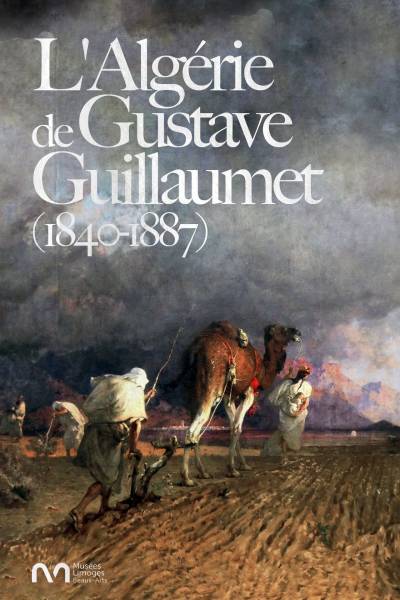Fiche Film
Arts plastiques
Interculturel/Migrations

COURT Métrage | 2018
L’Algérie de Gustave Guillaumet (1840-1887)

Date de sortie en France : 17/10/2018
Pays concerné : France
Durée : 6 minutes
Genre : portrait
Type : documentaire
Site web : www.youtube.com/watch?v=-LSwX5LobT0
Français
En 2018, une exposition majeure s'installe au musée des beaux-art de Limoges. Gustave Guillaumet (1840-1887) est un peintre qui s'inspire des premiers travaux photographiques pour la composition d'une partie de son œuvre. Réaliste il raconte l'histoire de l'Algérie des années 1860 et après. Il sera le témoin des violences, de la pauvreté du peuple et des conditions de vie. De la peinture d'histoire à la peinture de genre c’est l’évolution de l’artiste qui est à découvrir dans cette exposition
Né le 25 mars 1840, Gustave Guillaumet découvre l'Algérie par hasard alors qu'il devait s'embarquer pour l'Italie. Au fil de ses dix ou onze voyages et séjours prolongés, il a établi une familiarité avec cet espace. Parcourant les différentes régions du nord au sud, il n’a de cesse d’en noter les différences. Il est aussi le premier artiste, hors les Femmes d’Alger de Delacroix, à pénétrer dans les intérieurs féminins et à en révéler la réalité bien éloignée des fantasmes de harem qui règnent à son époque.Fasciné par le pays, ses déserts et ses habitants, allant jusqu’à vivre comme les Algériens, Gustave Guillaumet a consacré à ce pays sa vie et sa peinture, rompant avec les représentations de l’époque, colorées et exotiques. La toile La Famine en Algérie restaurée grâce à une exceptionnelle levée de fonds, fut dictée par les événements des années 1865-1868, et illustre bien sa connaissance du pays, d’une manière à la fois exigeante, sensible et grave.
<iframe width="560" height="315" src="https://www.youtube.com/embed/-LSwX5LobT0?si=OTcuo8fBJXdIYGjs" title="YouTube video player" frameborder="0" allow="accelerometer; autoplay; clipboard-write; encrypted-media; gyroscope; picture-in-picture; web-share" allowfullscreen></iframe>
https://www.youtube.com/watch?v=-LSwX5LobT0
Né le 25 mars 1840, Gustave Guillaumet découvre l'Algérie par hasard alors qu'il devait s'embarquer pour l'Italie. Au fil de ses dix ou onze voyages et séjours prolongés, il a établi une familiarité avec cet espace. Parcourant les différentes régions du nord au sud, il n’a de cesse d’en noter les différences. Il est aussi le premier artiste, hors les Femmes d’Alger de Delacroix, à pénétrer dans les intérieurs féminins et à en révéler la réalité bien éloignée des fantasmes de harem qui règnent à son époque.Fasciné par le pays, ses déserts et ses habitants, allant jusqu’à vivre comme les Algériens, Gustave Guillaumet a consacré à ce pays sa vie et sa peinture, rompant avec les représentations de l’époque, colorées et exotiques. La toile La Famine en Algérie restaurée grâce à une exceptionnelle levée de fonds, fut dictée par les événements des années 1865-1868, et illustre bien sa connaissance du pays, d’une manière à la fois exigeante, sensible et grave.
<iframe width="560" height="315" src="https://www.youtube.com/embed/-LSwX5LobT0?si=OTcuo8fBJXdIYGjs" title="YouTube video player" frameborder="0" allow="accelerometer; autoplay; clipboard-write; encrypted-media; gyroscope; picture-in-picture; web-share" allowfullscreen></iframe>
https://www.youtube.com/watch?v=-LSwX5LobT0
English
L’Algérie de Gustave Guillaumet (1840-1887)
In 2018, a major exhibition is taking place at the Limoges Museum of Fine Arts. Gustave Guillaumet (1840-1887) is a painter who draws inspiration from early photographic works for the composition of part of his work. Realistic, it tells the history of Algeria in the 1860s and after. He will witness the violence, the poverty of the people and the living conditions. From history painting to genre painting, the evolution of the artist can be discovered in this exhibition.
Born on March 25, 1840, Gustave Guillaumet discovered Algeria by chance when he was about to embark for Italy. Over the course of his ten or eleven trips and extended stays, he established a familiarity with this space. Traveling through the different regions from north to south, he never ceases to note the differences. He is also the first artist, apart from Delacroix's Women of Algiers, to penetrate into female interiors and reveal the reality, far removed from the harem fantasies that reigned in his time. Fascinated by the country, its deserts and its inhabitants , going so far as to live like the Algerians, Gustave Guillaumet devoted his life and his painting to this country, breaking with the colorful and exotic representations of the time. The painting The Famine in Algeria, restored thanks to exceptional fundraising, was dictated by the events of the years 1865-1868, and well illustrates his knowledge of the country, in a manner that is at once demanding, sensitive and serious.
<iframe width="560" height="315" src="https://www.youtube.com/embed/-LSwX5LobT0?si=OTcuo8fBJXdIYGjs" title="YouTube video player" frameborder="0" allow="accelerometer ; autoplay; clipboard-write; encrypted-media; gyroscope; picture-in-picture; web-share" allowfullscreen></iframe>
https://www.youtube.com/watch?v=-LSwX5LobT0
Born on March 25, 1840, Gustave Guillaumet discovered Algeria by chance when he was about to embark for Italy. Over the course of his ten or eleven trips and extended stays, he established a familiarity with this space. Traveling through the different regions from north to south, he never ceases to note the differences. He is also the first artist, apart from Delacroix's Women of Algiers, to penetrate into female interiors and reveal the reality, far removed from the harem fantasies that reigned in his time. Fascinated by the country, its deserts and its inhabitants , going so far as to live like the Algerians, Gustave Guillaumet devoted his life and his painting to this country, breaking with the colorful and exotic representations of the time. The painting The Famine in Algeria, restored thanks to exceptional fundraising, was dictated by the events of the years 1865-1868, and well illustrates his knowledge of the country, in a manner that is at once demanding, sensitive and serious.
<iframe width="560" height="315" src="https://www.youtube.com/embed/-LSwX5LobT0?si=OTcuo8fBJXdIYGjs" title="YouTube video player" frameborder="0" allow="accelerometer ; autoplay; clipboard-write; encrypted-media; gyroscope; picture-in-picture; web-share" allowfullscreen></iframe>
https://www.youtube.com/watch?v=-LSwX5LobT0
Partager :



